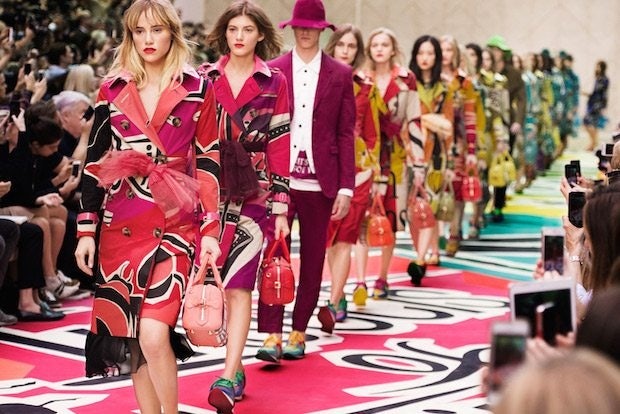
Burberry's S/S 15 collection. (Burberry)
When it comes to premium brands aiming for success in China, Burberry takes the lead in driving brand awareness and engaging with consumers.
That was the finding of the 2014 Bomoda Brand Index, a new study recently released by Bomoda Group, the research arm of Chinese online fashion community Bomoda. The index for brand achievement in China ranks premium fashion, beauty, and accessories brands using an algorithm calculating brand awareness, brand engagement, and consumer achievement. In order to reach its conclusions, the company scanned 250 different data points for brands’ competency on social media, search engines, mobile optimization, e-commerce, and more.
Burberry, which was categorized in the “accessible luxury” segment, came out on top across seven categories that included luxury, contemporary, high street, beauty, jewelry/watches/accessories, and multi-brand retailers. The brand’s strong social media marketing strategy that allowed its 2014 Spring/Summer collection to net 5.6 million views on Youku along with its foray into Tmall sales helped it earn the top ranking. Burberry also has around 21.5 million mentions on six leading fashion bulletin board sites in China, a number 16 times higher than any other brand in its category.

The top 10 brands across all categories in the 2014 Bomoda Brand Index. (Bomoda Group)
Meanwhile, Chanel was the leader of the “luxury" category thanks to its smart use of key opinion leaders (KOLs) on Chinese social media and emphasis on mobile devices with a Chinese-language mobile app and a Chinese mobile-optimized site. Close behind on the luxury list were Dior, Gucci, Armani, and Louis Vuitton.
Luxury didn’t do so well on the main list compared to other categories, however—the study found that labels in more mass categories such as accessible luxury, contemporary, and high street are more adept at brand-building in China. Chanel and Dior ranked 5th and 6th on the main list after the leader Burberry, Adidas, Nike, and Coach, while other luxury names were ranked further down the list between beauty brands such as Lancôme and high street labels such as Zara.

Bomoda's rankings of the top 15 brands in the luxury category of its brand index. (Bomoda Group)
According to Bomoda CEO Brian Buchwald, some luxury brands are misguided in thinking that their high-end image means they don’t necessarily need a strong digital strategy. “The irony is that luxury brands start with a major leg up with the consumer—we are talking about an aspirational buyer, and the likes of Chanel, YSL and Dior are the pantheon of that European lifestyle,” he says. “However, too many brands rest on the laurels of their name and logo. They may ‘broadcast’ to the consumer but they don’t do enough to ‘dialogue’ and engage further down the funnel.”
One main place where luxury brands are lacking is e-commerce. While the report used factors such as acceptance of Alipay to calculate scores, some luxury brands don’t have their own e-commerce channels at all in China. According to Buchwald, this is a major mistake given the prevalence of gray-market goods through practices such as daigou (buying abroad and selling online with no tariffs). “All brands are selling via e-commerce in China presently. The question is whether they are controlling their sales or third-party unlicensed resellers are controlling it. Our premise is that brands should own their own means of distribution, their pricing, the projection of their brand story and their communication with the consumer. That is impossible to do if they abdicate the e-commerce path.”

Statistics on the prevalence of daigou in China. (Bomoda Group)
The report also argues that brands like Chanel need to do their research on the KOLs they choose for promotions in order to reach the right audience. “The KOL should have the right voice and personal brand and verified followers in terms of who you would want to align with and through whom you want to project your story,” says Buchwald, noting that brands should also make sure that KOLs’ fan bases are completely organic. “Many KOLs have bought fake fans and engineered fake engagement to prop up their base.”
In order to gain success in the Chinese market, the report argues that brands need to adopt five key strategic approaches. First, they must build their brand based on the Chinese consumer journey from discovery to engagement and purchase, using data to discover their consumers’ preferences. In addition, companies need to localize their marketing approaches and price competitively with an awareness that many Chinese consumers are buying items abroad or through third-party channels. Furthermore, they need to embrace e-commerce on mobile channels, as well as develop authentic brand advocates that resonate with consumers.
According to Buchwald, luxury has a major advantage in these areas because “reputation will trump affordability at the high end for the new generation of buyers.” Which brands will be successful, however, is “still an open question, though one capable of being solved by the market participants themselves.”